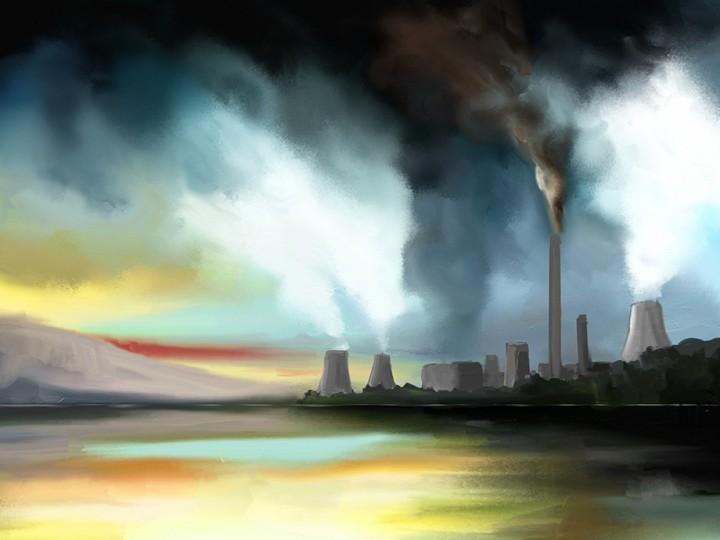
Ecosexuals Show the Planet Some Love on Earth Day
All around the globe, eco-conscious demonstrations develop in defense of our planet’s well-being, from scientists instructing us how to avoid a climactic doomsday to the 100-plus climate protesters who recently glued themselves to the tops of London commuter trains in the name of environmental justice.
Each of these gestures has its own way of drawing attention to the ever-present need for climate solutions, but there’s a blossoming environmental movement that somehow manages to deliver the same serious message in a manner that is intentionally whimsical, lighthearted and yes—sexy, too.
Members of the growing crusade that intertwines sex and eco-consciousness identify as ecosexual, which University of Nevada, Las Vegas instructor and sociologist Jennifer Reed defines as an expression of “an element of eroticism about nature” that can be traced back to the 1990s. Whereas some curse the wind for its tendency to ruin a hairstyle, an ecosexual individual regards those same gusts as gifts from nature and may even become aroused or reach orgasm by the mere thought of the air tickling their skin. In short, ecosexuality is a way to show love and appreciation for what Earth offers us on a daily basis.
Adjectives like quirky or off-kilter may seem suitable descriptors for such a lifestyle, but one word that doesn’t apply to ecosexuals is commitment-phobe, particularly for those who exchange vows with the planet itself during eco-themed weddings like the Marriage to the Earth ceremony UNLV’s Student Sustainability Council will host on Earth Day. Taking things beyond the Gaia theory’s assertion that Earth is a living, breathing organism, ecosexuality activism asks that we treat the planet like an equal partner in life instead of erecting (no pun intended) a barrier between humans and the physical environment.
From masturbating in hollowed out tree trunks to incorporating water, dirt and other elements into their sex lives, ecosexuals are redefining the art of seduction.
“The movement is about people expressing a deep connection with nature so that we’re situating humans as back in, as part of nature rather than separate from,” says Reed, the officiant of the April 22 ceremony.
While ecosexuality activism addresses a grave issue, there’s an unmistakable vibe of fun emanating from its community that sets it apart from other identity movements. The upbeat approach is a way to connect with others and invite people to take a closer look at environmental consciousness.
“A lot of what’s out there focuses on how catastrophic [climate change] could be,” Reed tells Playboy. “And when you start talking about catastrophes and extinction and things that scare people, it doesn’t give them a good way to engage. It scares them and shuts them down for the most part. So, to talk about things through the lens of ecosexuality... through performance art and through humor to engage with environmental issues, gives people a more hopeful, fun way to engage.”
From masturbating in hollowed out tree trunks to incorporating water, dirt and other elements into their sex lives, ecosexuals are redefining the art of seduction. But contrary to the opinions of skeptics, the ecosexual movement isn’t just about getting off to the wonders of our planet. Being extra familiar with the environment also extends to taking care of Earth so that it can continue to take care of us.
“People ask, ‘Is this just using sexuality to promote environmentalism?’” Reed says. “Sexuality does get used to promote environmentalism but it’s not in a superficial way.”
For the most vivid example of how sincere this collective commitment to the Earth is, look no further than ecosexual pioneers and couple Annie Sprinkle and Elizabeth Stephens. Together, the pair popularized the Marriage to Earth weddings and have performed hundreds of ceremonies all over the world. “We are the Earth, and so we thought we’ll marry the Earth because we love the Earth,” Stephens tells Playboy. “So, we married the Earth during a conference I produced and 450 people came.”
From that point, the movement continued to expand, taking Stephens and Sprinkle all over the world. “The next thing we know someone from Croatia called and said, ‘Hey can you marry the Earth in Zagreb?’” Stephens recalls. “We will do our art pretty much wherever we’re invited to do it if we can.”
When you start talking about catastrophes and extinction and things that scare people, it doesn’t give them a good way to engage. It scares them.
“Our goal with the ecosex moment is to make the environmental movement and sex education more sexy, fun and diverse, and to create a place where people who don’t fit in the Sierra Club can come together and do eco-sexy things and activism,” says Sprinkle, who along with Stephens, created a chart of ecosexual fetishes as well as the Ecosex Manifesto, a detailed explanation on what it means to commit to an ecosexual lifestyle.
“We invite the audience to take vows to love, honor and cherish whatever it is we’re marrying, and most people do take those vows, and they feel a very special connection with that entity,” Sprinkle says. In addition to emphasizing the obvious amorous aspect of the weddings, the ceremonies play a major role in raising awareness.
“For example, when we married Lake Kallavesi in Finland, this guy did a piece about how much water it takes to produce a sheet of paper. So it can be very educational as well but it can also be very romantic.”
So, what does a typical ecosexual wedding have that your average human-to-human ceremony doesn’t? As Reed explains, the environmentally friendly affairs can range from simple to elaborate. During Saturday’s ceremony, she will wear all green, a clear-cut homage to the planet. From a platform, she will recite standard vows for marrying the Earth that include declarations like, “Earth, we vow to become your lover,” and “We promise to listen to the Earth and take care of you.”
The event will also feature a wedding and photo booth for newlyweds who want to document their experiences, as well as a pledge tree, which, instead of marriage licenses, holds participants’ written and signed assertions of what they’re willing to change as they adopt a new perspective toward the planet. In ceremonies conducted by Stephens and Sprinkle, participants forego the traditional gowns and tuxedos for decorative costumes that symbolize their devotion to the Earth. Songs, spiritual chants and performances can take the place of a pop record-spinning DJ or live band. Material gifts are oftentimes discouraged in exchange for guests assisting with the ceremony. And unlike weddings many of us have attended, it isn’t unusual for those who wed the Earth to consummate the marriage during the ceremony.
Critics frequently bring the forth the question of consent, and Stephens has a succinct yet effective rebuttal for those who pointedly ask her if and how ecosexuality approaches the notion of getting permission from rocks or trees before engaging in human-to-non-human sensual acts.
“We ask questions also, like, ‘Did that rock consent to getting blown up so we can have a coal mine?’” she says.
In an example of life imitating art, Marge Piercy’s 1976 utopian, speculative sci-fi novel Woman on the Edge of Time, the main character Connie Ramos “travels” back and forth between modern-day New York City to a futuristic society in which sex and gender identities have devolved into a mere byproduct of the past. Instead of pronouns like “her” or “him,” people are simply referred to as “per,” a gender-neutral abbreviation for the word person. Coincidentally (or not?), this concept partially mirrors one of ecosexuality activism’s major themes.
“A big thing with the movement is people breaking down any kind of notions of there being dualisms, like between humans and nature…between men and women [or] the distinctions being made— the sexual part between being heterosexual and homosexual,” Reed explains. “These are false binaries that have been really promoted with and conditioned with this modern era that is responsible for a lot of the social and environmental problems that we see today. So, this movement really critiques those binaries.”
For those who aren’t quite ready to get down and dirty with the Earth, Sprinkle and Stephens suggest starting by simply acknowledging and appreciating the pleasure we experience from elements like feeling the warmth of sun rays or relishing in the oxygen trees produce.
“Wink at a cloud,” Stephens playfully adds. “You’re having intercourse with the air!”
And if you’re sexually active (which is not a requirement of ecosexual activism, by the way), you’re already participating in the movement. “Sex with people is also eco-sex,” Sprinkle explains. “Because you’re having sex with all the water in our bodies and all the minerals in our teeth,” Stephens says.
As for the future of the movement, there’s a general consensus of uncertainty, but there’s an equal amount of hope the ways in which ecosexuality can expand and empower society as a whole. “What we hope is that more people turn to the ecosex movement as a really loving and generative way of respecting and interacting with the Earth and with other people and animals and plants and minerals,” Stephens says.
“But you know sex is such a powerful drive… and I feel that if that could be combined with the drive to take care of the Earth, in a way, it really makes space for future life to flourish.”
RELATED: ENVIRONMENT

The Green Scare: How the Government is Minimizing Proof of Climate Change
Trump has been censoring government scientists, sidelining federal workers and ignoring evidence

Do Cities Have the Right to Sue Big Oil Over Climate Change?
A federal ruling could force the courts to police polluters.

How Fossil Fuels Could Go in the Way of the Tobacco Industry
When it comes to decreasing the use of fossil fuel, activists have a lot to learn from Big Tobacco

Governments Are Racing to Save the Planet with Renewable Energy, But for Whom?
Playboy's environment reporter takes a look at the displaced people of the green energy movement






